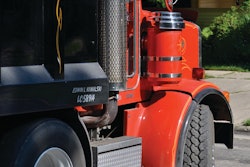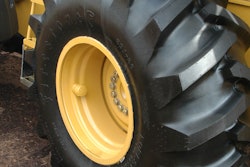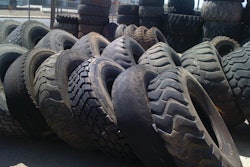As discussed in Part 1 of this series, a well-informed, well-defined tire maintenance and replacement strategy can enable fleet managers to save time and money, while decreasing downtime and increasing productivity. This strategy should include a plan for tire selection, repair and, when necessary, replacement.
Tire selection
The OTR tire industry has come up with nomenclature that makes the selection process for tires easier for buyers: E is for earthmover, L is for loader and G is for grader. However, Bill Porterfield, regional off-the-road (OTR) manager for Titan Tire Corporation, indicates there is more that must be considered in the selection process.
"The two major things you want to consider beyond tire type are compound and tread design. Choosing the right compound and tread design will mean better performance and longer tire life," says Porterfield. "The tire dealer should make recommendations on each, based on the operational and site assessments."
Porterfield goes on to explain that a cut-resistant compound would be good for rough applications where the machines are traveling at low speeds and short distances. Conversely, a high-speed haul application that is traveling longer distances would be better off with a heat-resistant compound.
Fleet Manager's Guide to a Tire Management Plan - Part 1
Tread design is also critical to performance and tire longevity. Along with the E, L and G nomenclature, comes a number from 1 through 5 that describes the tread depth, with 5 being the deepest.
"The deeper the treads, the more resistant those tires will be to punctures from sharp objects. So, for a loader running in an extremely rocky, harsh terrain, an L-5 would offer the most protection," explains Porterfield. "An L-5 may be overkill for less harsh settings, however, which is why it is important for the tire dealer to conduct a site assessment and determine what is most appropriate."
Furthermore, proper tire selection is based on operational factors such as distance, speed and load to determine adequate load capacities and ton-mile-per-hour (TMPH) ratings. The tire dealer will often suggest changes in operations in order to avoid premature tire fatigue. These recommendations, however, may require some compromise from the fleet manager.
"After the operational assessment, the tire dealer may conclude that the fleet's TMPH exceeds the limitations of the tire. When this happens, the tire dealer will often recommend traveling at lower speeds, running fewer cycles or carrying smaller loads," says Porterfield. "Such a suggestion is often hard to swallow for fleet managers, however. In the end, the tire dealer can consult with the fleet manager to decide which provides a greater cost savings — increased tire life or increased production."
Maintenance
In terms of regular maintenance, Porterfield stresses that monitoring inflation pressures is the most important task in prolonging tire life.
"Paying proper attention to inflation pressure can extend tire life by anywhere from 5% to 30%," says Porterfield. "So, I would recommend checking inflation pressures daily, before the machine has been started and is still cold."
He adds that problems with operator abuse can be diminished with the installation of pressure sensors. "With today's in-cab monitors, it's getting easier for operators to spot problems before they escalate," he notes. "If an operator realizes that a tire is even just 10 psi below where it should be, that should be cause for concern. Catching a problem early on could mean the difference between replacing a $40 valve and replacing the whole tire."
The strategy for tire rotation will depend on the individual machine. "For a three-axle haul truck, about 55% to 65% of gross vehicle weight is carried by the front tires when empty, so it's important to rotate the fronts to the rear at about one-third of the tires' expected life spans. When loaded, however, approximately one-third of the weight is distributed to each axle, so it's also important to look at how operational and site conditions affect tire wear in order to make a rotation recommendation," Porterfield states. "On a loader, you have to keep in mind that the front tires usually bear 65% of the load with a bucket attached. So, it's really important to rotate front to rear in order to give the front tires a rest for the remaining 50% of their projected life."
It's also important to know when to replace vs. repair. "A good rule of thumb is to consult your tire dealer on all repairs. Tire punctures aren't always straight, so pressing a plug straight into the tire could cause additional damage," says Porterfield. "If a tire is running low on tread, but is still holding air and is structurally sound, it may be a good candidate for retreading. The important thing to remember, however, is to pull that tire off with about 15% of the tread remaining. If it goes much further than that, and any of the under-tread compound is exposed, it's too late."
Successful implementation
"Ultimately, successful implementation of a tire management program takes buy-in from both the fleet manager and the operators," says Porterfield. "It's important for the fleet manager to train the operators to use the equipment within its limits and to report any changes in inflation pressure or job site conditions that could lead to potential problems."
Ongoing consultation from the tire dealer is also essential to a successful long-term program. "It's important to consult with the tire dealer as changes occur that could potentially affect the tire management program," says Porterfield. "As an operation expands, haul distances, speeds, loads, site conditions, cycle times and equipment configurations can all change. Each of these factors necessitates a change to the tire management program. As such, the fleet manager should work closely with his or her tire dealer for recommendations whenever major changes occur."
As a regional OTR tire manager for Titan Tire Corporation, Bill Porterfield has spent 38 years in the tire industry, helping tire dealers implement tire management programs for their customers in the construction, aggregate and mining industries.



















